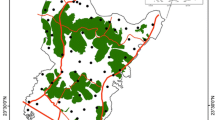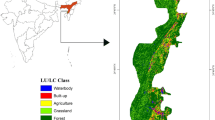Abstract
The paper explored the level of forest disturbance in the Sariska Tiger Reserve (STR) of Indian tropical forest. We acquired single scene image of Landsat-5 (1989) and Landsat-8 (2015) for the analysis. Disturbance map was produced using fragmentation and canopy density models. The map was categorized into high, moderate, low, and undisturbed forest tracts. Spatiotemporal analysis of forest disturbance (1989–2015) revealed that highly disturbed tracts experienced a decrease of 43%, while medium and low disturbed tracts showed an increase of 57% and 30%, respectively. Undisturbed forest tracts witnessed decrease mainly due to a decrease in very high canopy density and increase in forest fragmentation. Within cores I, II and III of STR, undisturbed forest tracts in core I have significantly declined due to increased anthropogenic activities. Thus, the study calls for immediate attention to check forest disturbance in core I of STR. Though the government has initiated relocation program of the villages and restoration of the STR, the execution process has still a long way to achieve the goal. The methodology adopted in this study can effectively be utilized for assessing the forest disturbance tracts at spatial scales.







Similar content being viewed by others
References
Abdullah SA, Nakagoshi N (2007) Forest fragmentation and its correlation to human land use change in the state of Selangor, peninsular Malaysia. For Ecol Manag 241(1–3):39–48
Asner GP (2013) Geography of forest disturbance. PNAS 110(10):3711–3712
Azizia Z, Najafi A, Sohrabia H (2008) Forest canopy density estimating, using satellite images. The International Archives of the Photogrammetry. Remote Sens Spat Inf Sci 37(B8):1127–1130
Banerjee R, Srivastava PK (2013) Reconstruction of contested landscape: detecting land cover transformation hosting cultural heritage sites from Central India using remote sensing. Land Use Policy 34:193–203
Butler BJ, Swenson JJ, Alig RJ (2004) Forest fragmentation in the Pacific Northwest: quantification and correlations. For Ecol Manag 189(1–3):363–373
Cale PG, Hobbs RJ (1994) Landscape heterogeneity indices: problems of scale and applicability, with particular reference to animal habitat description. Pac Conserv Biol 1(3):183–193
Champion HG, Seth SK (1968) The forest types of India. The government of India Press, New Delhi
CLEAR (2002) Forest fragmentation in Connecticut: 1985–2006. Center for land use education and research. http://clear.uconn.edu/projects/landscape/forestfrag
Cohen WB, Fiorella M, Gray J, Helmer E, Anderson K (1998) An efficient and accurate method for mapping forest clearcuts in the Pacific Northwest using Landsat imagery. Photogr Eng Remote Sens 64(4):293–299
Congalton RG, Green K (2002) Assessing the accuracy of remotely sensed data: principles and practices. CRC Press, Boca Raton
Dale VH, Joyce LA, McNulty S, Neilson RP, Ayres MP, Flannigan MD, Simberloff D (2001) Climate change and forest disturbances: climate change can affect forests by altering the frequency, intensity, duration, and timing of fire, drought, introduced species, insect and pathogen outbreaks, hurricanes, windstorms, ice storms, or landslides. Bioscience 51(9):723–734
Danneyrolles V, Dupuis S, Fortin G, Leroyer M, de Römer A, Terrail R, Arseneault D (2019) Stronger influence of anthropogenic disturbance than climate change on century-scale compositional changes in northern forests. Nat Commun 10(1):1265
Deka J, Tripathi OP, Khan ML (2013) Implementation of forest canopy density model to monitor tropical deforestation. J Indian Soc Remote Sens 41(2):469–475
Dornelas M (2010) Disturbance and change in biodiversity. Philos Trans R Soc Lond B: Biol Sci 365(1558):3719–3727
Gibson L, Lynam AJ, Bradshaw CJ, He F, Bickford DP, Woodruff DS, Laurance WF (2013) Near-complete extinction of native small mammal fauna 25 years after forest fragmentation. Science 341(6153):1508–1510
GoR (2004) Management plan for Sariska Tiger Reserve. Jaipur, Rajasthan
Gray RE, Ewers RM, Boyle MJ, Chung AY, Gill RJ (2018) Effect of tropical forest disturbance on the competitive interactions within a diverse ant community. Sci Rep 8(1):5131
Healey SP, Cohen WB, Zhiqiang Y, Krankina ON (2005) Comparison of Tasseled Cap-based Landsat data structures for use in forest disturbance detection. Remote Sens Environ 97(3):301–310
Heilman GE, Strittholt JR, Slosser NC, Dellasala DA (2002) Forest Fragmentation of the Conterminous United States: assessing Forest Intactness through Road Density and Spatial Characteristics: Forest fragmentation can be measured and monitored in a powerful new way by combining remote sensing, geographic information systems, and analytical software. Bioscience 52(5):411–422
Hérault B, Piponiot C (2018) Key drivers of ecosystem recovery after disturbance in a neotropical forest. For Ecosyst 5(1):2
Huang C, Goward SN, Schleeweis K, Thomas N, Masek JG, Zhu Z (2009) Dynamics of national forests assessed using the Landsat record: case studies in eastern United States. Remote Sens Environ 113(7):1430–1442
Huang C, Goward SN, Masek JG, Thomas N, Zhu Z, Vogelmann JE (2010) An automated approach for reconstructing recent forest disturbance history using dense Landsat time series stacks. Remote Sens Environ 114(1):183–198
Huo LZ, Boschetti L, Sparks AM (2019) Object-based classification of forest disturbance types in the conterminous United States. Remote Sens 11(5):477
Jain P, Sajjad H (2016a) Analysis of willingness for relocation of the local communities living in the Critical Tiger Habitat of the Sariska Tiger Reserve, India. Local Environ 21(11):1409–1419
Jain P, Sajjad H (2016b) Household dependency on forest resources in the Sariska Tiger Reserve (STR), India: implications for management. J Sustain For 35(1):60–74
Jain P, Ahmed R, Sajjad H (2016) Assessing and monitoring forest health using a forest fragmentation approach in Sariska Tiger Reserve, India. Norsk Geografisk Tidsskrift-Norwegian J Geogr 70(5):306–315
Jennings SB, Brown ND, Sheil D (1999) Assessing forest canopies and understorey illumination: canopy closure, canopy cover and other measures. For Int J For Res 72(1):59–74
Karanth KK, Curran LM, Reuning-Scherer JD (2006) Village size and forest disturbance in Bhadra wildlife sanctuary, Western Ghats, India. Biol Conserv 128(2):147–157
Kennedy RE, Cohen WB, Schroeder TA (2007) Trajectory-based change detection for automated characterization of forest disturbance dynamics. Remote Sens Environ 110(3):370–386
Kennedy RE, Yang Z, Cohen WB (2010) Detecting trends in forest disturbance and recovery using yearly Landsat time series: 1. LandTrendr—Temporal segmentation algorithms. Remote Sens Environ 114(12):2897–2910
Kumar M, Singh MP, Singh H, Dhakate PM, Ravindranath NH (2019) Forest working plan for the sustainable management of forest and biodiversity in India. J Sustain For 1:1–22
MacLean MG, Congalton RG (2010) Mapping and analysis of fragmentation in southeastern New Hampshire. In: ASPRS/CaGUS 2010 fall specialty conference, pp 15–19
Maren IE, Karki S, Prajapati C, Yadav RK, Shrestha BB (2015) Facing north or south: does slope aspect impact forest stand characteristics and soil properties in a semiarid trans-Himalayan valley? J Arid Environ 121:112–123
McGarigal K, Marks BJ (1995) FRAGSTATS: spatial pattern analysis program for quantifying landscape structure. General Technical Report (GTR). U.S. Department of Agriculture, Forest Service, Pacific Northwest Research Station, 122 p
Mitchell AL, Rosenqvist A, Mora B (2017) Current remote sensing approaches to monitoring forest degradation in support of countries measurement, reporting and verification (MRV) systems for REDD+. Carbon Bal Manag 12(1):9
Murayama YKKL, Lwin KK (2010) Estimation of Landsat TM Surface Temperature Using ERDAS Imagine Spatial Modeler. Division of Spatial Information Science Graduate School of Life and Environmental Sciences, University of Tsukuba
Nandy S, Joshi PK, Das KK (2003) Forest canopy density stratification using biophysical modeling. J Indian Soc Remote Sens 31(4):291–297
NTCA: National Tiger Conservation Authority (2010) Compendium of guidelines/advisories/gazette notification. Government of India, New Delhi
Ozdogan M (2014) A practical and automated approach to large area forest disturbance mapping with remote sensing. PLoS One 9(4):1
Parent J, Civco D, Hurd J (2007) Simulating future forest fragmentation in a Connecticut region undergoing suburbanization. In: ASPRS 2007 Annual Conference Tampa, Florida
Pfeifer M, Gonsamo A, Woodgate W, Cayuela L, Marshall AR, Ledo A, Courtney-Mustaphi C (2018) Tropical forest canopies and their relationships with climate and disturbance: results from a global dataset of consistent field-based measurements. For Ecosyst 5(1):7
Polevshchikova I (2019) Disturbance analyses of forest cover dynamics using remote sensing and GIS. IOP Conf Ser Earth Environ Sci 316(1):012053
Reddy CS, Sreelekshmi S, Jha CS, Dadhwal VK (2013) National assessment of forest fragmentation in India: landscape indices as measures of the effects of fragmentation and forest cover change. Ecol Eng 60:453–464
Riitters K, Wickham J, O’Neill R, Jones B, Smith E (2000) Global-scale patterns of forest fragmentation. Conserv Ecol 4(2):1
Riitters KH, Wickham JD, O’neill RV, Jones KB, Smith ER, Coulston JW, Smith JH (2002) Fragmentation of continental United States forests. Ecosystems 5(8):0815–0822
Rikimaru A (1996) Landsat TM data processing guide for forest canopy density mapping and monitoring model. In: ITTO workshop on utilization of remote sensing in site assessment and planning for rehabilitation of logged-over forest, Bangkok, Thailand. 8:1–8
Rikimaru A, Roy PS, Miyatake S (2002) Tropical forest cover density mapping. Trop Ecol 43(1):39–47
Roy PS, Sharma KP, Jain A (1996) Stratification of density in dry deciduous forest using satellite remote sensing digital data—an approach based on spectral indices. J Biosci 21(5):723–734
Roy PS, Miyatake S, Rikimaru A (1997) Biophysical spectral response modeling approach for forest density stratification. In: Proceedings of the 18th Asian conference on remote sensing
Sahana M, Sajjad H, Ahmed R (2015) Assessing spatio-temporal health of forest cover using forest canopy density model and forest fragmentation approach in Sundarban Reserve forest, India. Modeling Earth Syst Environ 1(4):49
Sahana M, Ahmed R, Jain P, Sajjad H (2016) Driving force for forest fragmentation explored by land use change in Song watershed, India. Spat Inf Res 24(6):659–669
Schroeder TA, Healey SP, Moisen GG, Frescino TS, Cohen WB, Huang C, Yang Z (2014) Improving estimates of forest disturbance by combining observations from Landsat time series with US Forest Service Forest Inventory and Analysis data. Remote Sens Environ 154:61–73
Seiler A, Folkeson L (2003) COST 341—Habitat fragmentation due to transportation infrastructure: The Swedish National Review. Office for Official Publications of the European Communities, Luxembourg
Senf C, Seidl R, Hostert P (2017) Remote sensing of forest insect disturbances: current state and future directions. Int J Appl Earth Obs Geoinf 60:49–60
Singh SK, Srivastava PK, Szabó S, Petropoulos GP, Gupta M, Islam T (2017) Landscape transform and spatial metrics for mapping spatiotemporal land cover dynamics using Earth Observation data-sets. Geocarto Int 32(2):113–127
Southworth J, Nagendra H, Tucker C (2002) Fragmentation of a landscape: incorporating landscape metrics into satellite analyses of land-cover change. Landsc Res 27(3):253–269
Southworth J, Munroe D, Nagendra H (2004) Land cover change and landscape fragmentation—comparing the utility of continuous and discrete analyses for a western Honduras region. Agr Ecosyst Environ 101(2–3):185–205
Szabó S, Túri Z, Márton S (2014) Factors biasing the correlation structure of patch level landscape metrics. Ecol Indic 36:1–10
Tang X, Bullock EL, Olofsson P, Estel S, Woodcock CE (2019) Near real-time monitoring of tropical forest disturbance: new algorithms and assessment framework. Remote Sens Environ 224:202–218
Túri Z, Szabó S (2008) The role of resolution on landscape metrics based analysis. Acta Geographica Silesiana 4(1):47–52
Turner BL, Clark WC, Kates RW, Richards JF, Mathews JT, Meyer WB (1990) The earth as transformed by human action. Cambridge Univ Press, Cambridge, p 713
Vogt P, Riitters KH, Estreguil C, Kozak J, Wade TG, Wickham JD (2007) Mapping spatial patterns with morphological image processing. Landscape Ecol 22(2):171–177
Acknowledgement
The authors are grateful to the Reviewers and Editors for their constructive comments and valuable suggestions which helped us to improve the overall quality of the manuscript. We are also thankful to Forest Department officials for their help and cooperation during visit to the study area.
Author information
Authors and Affiliations
Corresponding author
Additional information
Publisher's Note
Springer Nature remains neutral with regard to jurisdictional claims in published maps and institutional affiliations.
Rights and permissions
About this article
Cite this article
Jain, P., Ahmed, R., Rehman, S. et al. Detecting disturbed forest tracts in the Sariska Tiger Reserve, India, using forest canopy density and fragmentation models. Model. Earth Syst. Environ. 6, 1373–1385 (2020). https://doi.org/10.1007/s40808-020-00755-4
Received:
Accepted:
Published:
Issue Date:
DOI: https://doi.org/10.1007/s40808-020-00755-4




